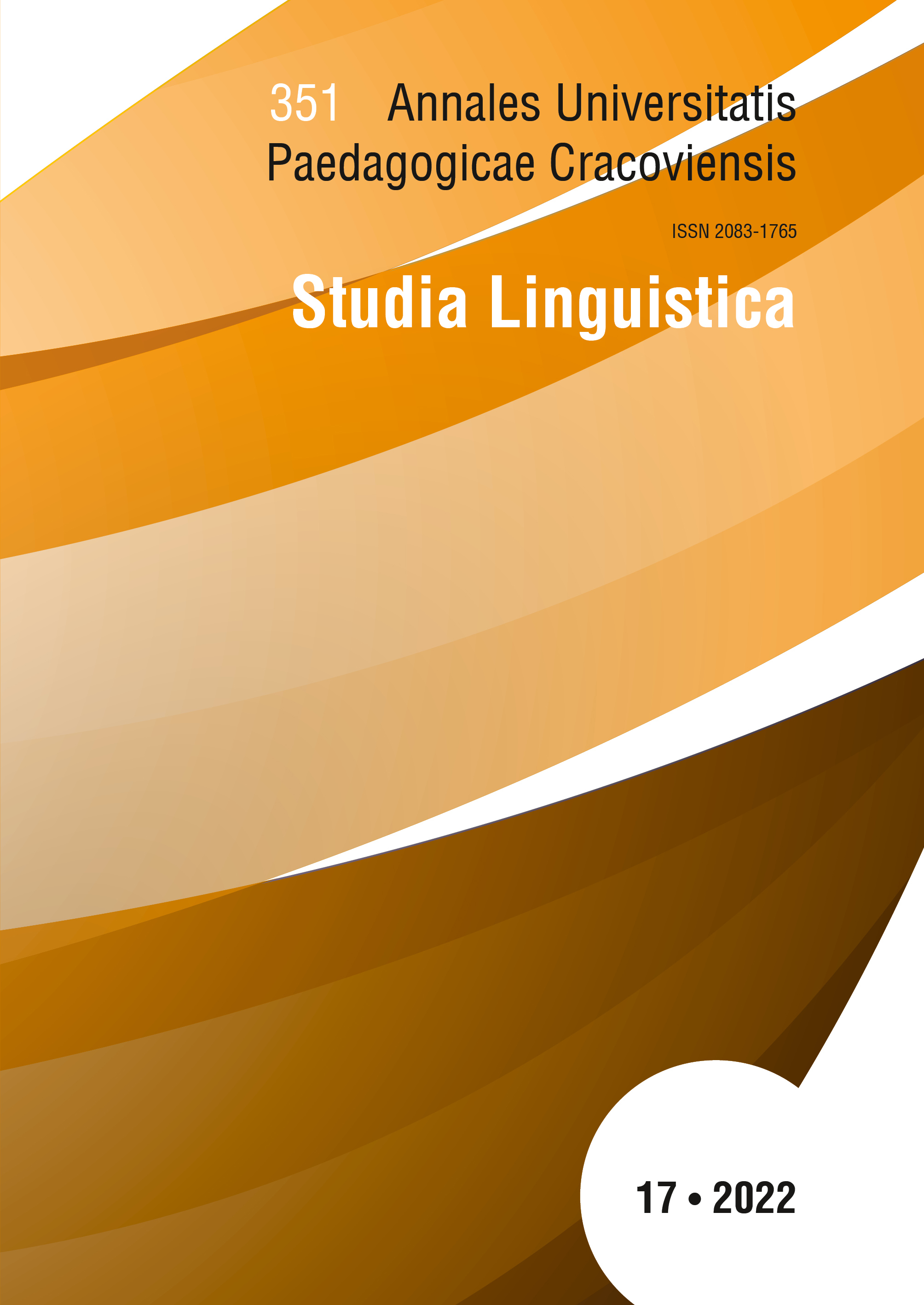Nazwy zespołów i tytuły utworów disco polo. Rekonesans onomastyczno-kulturowy
Main Article Content
Abstrakt
In the article, I discuss the names of disco polo bands (disco polo is a kind of Polish pop music) and songs. I analyse the names from the linguistic and cultural perspective. I also highlight the external contexts. I also treat the onomastic layer of disco polo as a sign of cognitive conceptualisations, being the basis of the creation of images of the world in the lyrics.
Downloads
Article Details

Utwór dostępny jest na licencji Creative Commons Uznanie autorstwa – Użycie niekomercyjne – Bez utworów zależnych 4.0 Międzynarodowe.
Autor, zgłaszając tekst do redakcji czasopisma „Annales Universitatis Paedagogicae Cracoviensis. Studia Linguistica”, zaświadcza, iż jest on rezultatem wyłącznie jego własnej twórczości, że treść artykułu nie była dotychczas publikowana oraz że utwór nie narusza w żadnym stopniu praw autorskich ani praw pokrewnych innych osób, jak również innych praw osób trzecich, a także, że niczyje prawa do utworu (lub jego jakiejkolwiek części) nie zostały pominięte. Po podpisaniu umowy prawa majątkowe do opublikowanych materiałów zostają przeniesione na Wydawnictwo Naukowe Uniwersytetu Komisji Edukacji Narodowej w Krakowie.
Rocznik „Annales Universitatis Paedagogicae Cracoviensis. Studia Linguistica” to czasopismo o otwartym dostępie, a cała jego zawartość jest udostępniana bezpłatnie dla użytkowników i instytucji na zasadach licencji Creative Commons CC-BY-NC-ND 4.0 (uznanie autorstwa, użycie niekomercyjne, bez utworów zależnych). Na podstawie tej licencji autorzy zgadzają się, że ich prace mogą być zgodnie z prawem ponownie wykorzystywane do jakichkolwiek celów, za wyjątkiem celów komercyjnych, bez konieczności uzyskania uprzedniej zgody ze strony autora lub wydawcy. Każdy może prace te czytać, pobierać, kopiować, drukować, rozpowszechniać oraz przetwarzać, pod warunkiem poprawnego oznaczenia autorstwa oraz oryginalnego miejsca publikacji. Publikowanych tekstów nie można wykorzystywać do tworzenia utworów zależnych (np. do tłumaczenia ich i publikowania w innym języku bez zgody wydawcy). Jest to zgodne z definicją otwartego dostępu BOAI (Budapest Open Access Initiative) „Studia Linguistica”nie pobiera opłat za składanie artykułów ani ich przetwarzanie.
Autor, przesyłając artykuł do redakcji „Studia Linguistica”, bezwględnie zgadza się z poniższymi punktami:
-
Oświadczam, że jestem Autorem lub Współautorem nadesłanego tekstu. Przesłany tekst nie był nigdzie publikowany, jest całkowicie oryginalny i nie narusza w żadnym stopniu praw autorskich ani praw pokrewnych innych osób, jak również innych praw osób trzecich, a także, że niczyje prawa do utworu nie zostały pominięte.
-
Oświadczam, że nadesłany tekst nie został złożony do recenzji lub/i publikacji w innym czasopiśmie.
-
Przyjmuję do wiadomości, że Autor ponosi pełną odpowiedzialność za każdy przypadek plagiatu, niezależnie od tego, czy został on wykryty podczas procesu recenzji, czy po publikacji w „Studia Linguistica”.
-
Oświadczam, że ponoszę pełną odpowiedzialność finansową i prawną za wszelkie roszczenia związane z utworem.
-
Potwierdzam uznanie wszystkich źródeł danych wykorzystanych i cytowanych w badaniach.
-
Potwierdzam, że artykuł został wykonany z należytą starannością zgodnie ze standardami edytorskimi „Studia Linguistica”.
Bibliografia
Borys M., 2015, Polski Bayer. Obrazy disco polo w latach 90., „Widok. Teorie i praktyki kultury wizualnej”, nr 11, s. 1–21.
Google Scholar
Borys M., 2019, Polski Bajer. Disco polo i lata 90., Warszawa.
Google Scholar
Czernek P., 2016, Nazwy polskich zespołów muzycznych (na przykładzie grup powstałych w latach 1980-2000), niepublikowana praca doktorska.
Google Scholar
Duszak A., 1998, Tekst, dyskurs, komunikacja międzykulturowa, Warszawa.
Google Scholar
Filar W., 2014, Fenomen muzyki disco polo w kontekście polskiej kultury popularnej lat 90., „Kultura Popularna”, nr 1, s. 102–119.
Google Scholar
Kuligowski W., 2002, Popkultura jako źródło tożsamości, „Kultura Popularna”, nr 0, s. 19–26.
Google Scholar
Łączniak J., 2017, Dyskursywny obraz miłości w tekstach disco polo z lat 2014–2016, „Dziennikarstwo i Media”, nr 8, s. 79–100.
Google Scholar
Narębska M., 1997, Leksyka tekstów nurtu disco polo, „Literatura Ludowa” 1997, nr 6, s. 33–53.
Google Scholar
Naruszewicz-Duchlińska A., 1998, Nazwy współczesnych polskich zespołów muzycznych, „Zeszyty Naukowe Wyższej Szkoły Pedagogicznej w Olsztynie. Prace Językoznawcze”, z. 2, s. 38–44.
Google Scholar
Perez C.C., 2020, Niewidzialne kobiety. Jak dane tworzą świat skrojony pod mężczyzn, tłum. A. Sak, Kraków.
Google Scholar
Skowronek B., 2010, Nie elitarna, nie popularna – po prostu kultura, „Polonistyka”, nr 5, s. 6–12.
Google Scholar
Skowronek K., Rutkowski M., 2004, Media i nazwy. Z zagadnień onomastyki medialnej, Kraków.
Google Scholar
Skowronek B., Zborowska N., 2021, Disco polo. Analiza lingwistyczno-kulturowa, Kraków.
Google Scholar
Storey J., 2003, Studia kulturowe i badania kultury popularnej. Teorie i metody, tłum. i red. J. Barański, Kraków.
Google Scholar
